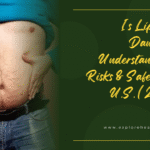Multifocal pneumonia might sound like a complicated medical term, but it’s a condition that affects thousands of Americans each year. Whether caused by bacteria, viruses, or fungi, this illness can become serious quickly if left untreated. With recent respiratory outbreaks and changing health trends in the United States, it’s more important than ever to understand the facts.
In this article, we’ll break down what multifocal pneumonia is, what causes it, who’s most at risk, and how it’s treated. We’ll also explore current U.S. data, recent medical insights, and what you can do to stay protected in 2025.
What Is Multifocal Pneumonia?
Multifocal pneumonia is a type of lung infection where multiple areas (or “foci”) in both lungs become inflamed or infected at the same time. Unlike lobar pneumonia, which affects a single lobe, multifocal pneumonia affects different sections and can be more severe, especially in vulnerable populations.
How It Differs from Other Pneumonia Types
- Lobar pneumonia: Affects one part or lobe of the lung.
- Bronchopneumonia: Starts in the bronchi and spreads to nearby lung tissue.
- Multifocal pneumonia: Involves several distinct infected spots across one or both lungs.
Common Causes of Multifocal Pneumonia
Multifocal pneumonia can be caused by a variety of pathogens:
- Bacterial infections (e.g., Streptococcus pneumoniae, Staphylococcus aureus)
- Viral infections (e.g., influenza, RSV, or SARS-CoV-2)
- Fungal infections (more common in immunocompromised individuals)
- Aspiration (inhaling food, liquids, or vomit into the lungs)
In 2024 and early 2025, the CDC has reported an uptick in multifocal cases related to Mycoplasma pneumoniae and Influenza A, particularly during winter months. According to CDC.gov, viral pneumonia continues to contribute significantly to hospitalizations across the U.S.
Who’s Most at Risk?
Multifocal pneumonia can impact anyone, but certain groups are more likely to develop severe illness:
- Adults over age 65
- Children under 5
- Individuals with chronic illnesses (COPD, diabetes, heart disease)
- Immunocompromised individuals (cancer patients, transplant recipients, those on immunosuppressants)
- Smokers
- People living in crowded or unsanitary conditions
A 2024 study published in the American Journal of Respiratory and Critical Care Medicine noted a 20% higher hospitalization rate among older adults diagnosed with multifocal pneumonia compared to those with localized forms.
Symptoms to Watch For
Symptoms of multifocal pneumonia often mimic those of other respiratory illnesses, but tend to be more intense due to the spread of infection across multiple lung areas.
Common signs include:
- Persistent cough (may produce mucus or pus)
- Shortness of breath
- High fever and chills
- Chest pain, especially during breathing or coughing
- Fatigue and weakness
- Confusion (especially in elderly patients)
- Low oxygen levels (hypoxia)
If these symptoms worsen quickly or don’t improve with over-the-counter medications, seek medical care immediately.
Diagnosis and Testing
To confirm a case of multifocal pneumonia, doctors typically use:
- Chest X-rays or CT scans: Reveal multiple infected areas in the lungs
- Blood tests: Look for signs of infection or inflammation
- Sputum culture: Identifies specific pathogens
- Pulse oximetry: Measures oxygen saturation in the blood
In 2025, rapid diagnostic panels—like the ones endorsed by NIH.gov—are being used more frequently in emergency rooms to identify the exact cause within hours.
Treatment Options
Treatment varies based on the underlying cause (bacterial, viral, fungal):
For Bacterial Pneumonia:
- Antibiotics (broad-spectrum first, then targeted based on culture results)
- Intravenous (IV) fluids and oxygen support, if hospitalized
For Viral Pneumonia:
- Antiviral medications (e.g., oseltamivir for flu)
- Rest, fluids, fever reducers
For Fungal Pneumonia:
- Antifungal medications (usually oral or IV depending on severity)
In serious cases, patients may require hospitalization and even mechanical ventilation. Early treatment significantly reduces complications and improves recovery time.
Recovery and Long-Term Outlook
Most people recover from multifocal pneumonia with appropriate treatment, though recovery may take weeks to months, especially in older adults. Residual fatigue and lung inflammation are common for several weeks post-infection.
Tips for a Healthy Recovery:
- Follow your doctor’s medication plan fully
- Avoid smoking or secondhand smoke
- Rest often and stay hydrated
- Schedule follow-up chest imaging if advised
- Consider pulmonary rehabilitation if breathing remains difficult
U.S. Trends: Multifocal Pneumonia in 2024–2025
Recent winters have seen spikes in respiratory infections, with multifocal pneumonia emerging more frequently due to coinfections (like flu and RSV occurring together). Hospitals in states like New York, Michigan, and California reported capacity strain during peak months in late 2024.
In response, healthcare providers have been emphasizing flu vaccines, RSV vaccines (for older adults), and improved ventilation in schools and workplaces.
According to MedlinePlus.gov, public awareness campaigns and early intervention have played a critical role in reducing fatality rates, even as case numbers temporarily increase.
Prevention Tips
While not all cases of multifocal pneumonia are preventable, there are key steps you can take to lower your risk:
- Stay current on vaccinations (flu, COVID-19, pneumococcal, and RSV for those eligible)
- Practice good hygiene (frequent handwashing, disinfecting surfaces)
- Avoid close contact with people showing signs of respiratory illness
- Quit smoking or avoid exposure to smoke
- Manage chronic conditions like asthma or heart disease carefully
When to Seek Medical Help
Always consult a doctor if you experience:
- Difficulty breathing
- High fever that persists beyond 3 days
- Chest pain with breathing
- Confusion or altered mental state
- Blue lips or fingernails (a sign of low oxygen)
Delaying treatment for multifocal pneumonia can result in serious complications, including respiratory failure or sepsis.
Conclusion: Stay Informed, Stay Protected
Multifocal pneumonia is a serious but treatable condition. Understanding its causes, symptoms, and treatments—along with current U.S. trends—can help you or your loved ones take timely action. Whether you’re caring for an older adult or managing your own health, staying vigilant and prepared can make all the difference in 2025.
If you or someone in your family is experiencing symptoms of multifocal pneumonia, don’t wait—schedule a check-up with your healthcare provider today. Prevention, early diagnosis, and proper treatment are key to a full recovery.
About ExploreHealthToday.com
ExploreHealthToday.com was created to be a one-stop resource where readers can find up-to-date, well-researched articles on a variety of health topics. From nutrition and wellness to lifestyle and mental health, we strive to provide reliable information to help you make informed decisions about your well-being.
We believe that good health starts with good information, and our mission is to empower our readers with knowledge they can trust.
Visit us at ExploreHealthToday.com to learn more.





